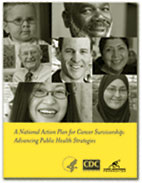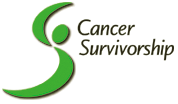

|
 |

Cancer Survivorship >
Brochure
Survive Cancer and Live

You may also download a PDF version
of Survive Cancer and Live (154K) for
Adobe Acrobat Reader.
On this page
Who Are Cancer Survivors?
Cancer survivors are people who have been diagnosed with cancer and those people
in their lives who are affected by the diagnosis, including family members,
friends, and caregivers.
|
The Cancer Burden: Facts and Hope for the Future
Cancer is the second leading cause of death in the United States, causing 1 of
every 4 deaths each year (ACS, 2004). Everyone is at risk of developing some
form of cancer. Cancer incidence varies by race and ethnicity, with some groups
being more susceptible to certain types of cancers than others. Age is also
a primary risk factor for most cancers, with about 77% of all cancers diagnosed
among people aged 55 years or older. If current trends continue, one-third of Americans
will be diagnosed with cancer in their lifetimes (NCI, 2003).
Improvements in screening practices and rates, early detection, and cancer
treatment and care are allowing more and more people to live "beyond" cancer each year. The number of people affected by cancer, both those diagnosed
with the disease and their families and friends, is substantial. As of January
2000, approximately 9.6 million people with cancer were living in the United
States (NCI, 2003), and this number does not include others affected such as
family members, caregivers, and friends of cancer patients. Scientists expect
the number of survivors to increase steadily over the coming years.
References
American Cancer Society (ACS). Cancer Facts & Figures 2004. Atlanta,
GA: American Cancer Society; 2004.
National Cancer Institute (NCI). Cancer Control and Population Sciences:
Research Findings [online]. Available at: http://dccps.nci.nih.gov/ocs/prevalence/index.html;
2003.
Top of Page
Redefining a Cancer Survivor and Public Health's Role in Cancer Survivorship

The term cancer survivor is now commonly used to describe a person
from the time of cancer diagnosis through the remaining years of life. The National
Action Plan supports expanding the definition of cancer survivor to include
caregivers, family members, and friends.
Survivors face numerous physical, psychological, social, spiritual, and financial
issues at diagnosis, during treatment, and throughout the remaining years of
their lives. Cancer survivors could benefit tremendously from a coordinated
public health effort to address their quality of life throughout the cancer
experience.
The public health community could play an integral role in increasing the understanding
of the physical, emotional, spiritual, and social effects of cancer, as well
as applying existing knowledge about potential interventions for improving survivors’
quality of life. Creating and implementing successful strategies to help the
millions of people who live with, through, and beyond cancer remain the overarching
goals of survivorship efforts.
Top of Page
The National Action Plan

The Centers for Disease Control and Prevention (CDC) collaborated with the Lance
Armstrong Foundation (LAF) and key partners, including numerous not-for-profit organizations,
advocates, survivors, and researchers, to identify and prioritize cancer survivorship
needs within a public health context. Through this partnership, A National
Action Plan for Cancer Survivorship: Advancing Public Health Strategies
was developed.
The National Action Plan can be used by government agencies, private
and not-for-profit organizations, and individuals to select and develop activities
that best suit their available resources and missions. The implementation of
this National Action Plan will increase awareness and stimulate action
to improve the overall experience and quality of life for the millions of Americans
who are living with, through, and beyond cancer.
If you would like to order a copy of A
National Action Plan for Cancer Survivorship: Advancing Public Health Strategies, please visit the
Cancer Publications Center.
"Together CDC and the LAF are charting a
new course for the public health community to help cancer survivors enjoy all the wonderful
things life has to offer."
Julie Gerberding, MD, MPH
Director of the Centers for Disease Control and Prevention
|
Top of Page
23 Recommended Needs
Using core public health functions and services as a guide, the National
Action Plan identifies priority needs within four public health areas:
- surveillance and applied research
- communication, education, and training
- programs, policies and infrastructure
- access to quality care and services
The following list includes five cross-cutting and 18 priority needs that were identified through
the development process. Strategies for addressing these needs are detailed
in the National Action Plan.
Cross-cutting Needs:
- Develop an infrastructure for a comprehensive database on cancer survivorship.
- Develop, test, maintain, and promote patient navigation systems that can
facilitate optimum care for cancer survivors.
- Establish and disseminate clinical practice guidelines for each stage
of cancer survivorship.
- Develop and disseminate public education programs that empower cancer survivors
to make informed decisions.
- Conduct ongoing evaluation of activities to determine their impacts and
outcomes and ensure continuous quality improvement of services.
Priority Needs:
- Enhance the existing surveillance and applied research infrastructure.
- Identify factors associated with ongoing health concerns of cancer survivors.
- Determine programs and services that best address the needs of cancer survivors.
- Conduct research on preventive interventions to evaluate their impact on
issues related to cancer survivorship.
- Translate applied research into practice.
- Develop strategies to educate the public that cancer is a chronic disease
people can and do survive.
- Educate policy- and decision-makers about the role and value of providing
long-term follow-up care, addressing quality-of-life issues and legal needs, and
ensuring access to clinical trials and ancillary services for cancer survivors.
- Empower survivors with advocacy skills.
- Teach survivors how to access and evaluate available information.
- Educate health care providers about cancer survivorship from diagnosis through
long-term treatment and end-of-life care.
- Identify and implement programs proven to be effective (i.e., best practices).
- Implement evidence-based cancer plans that include goals and strategies for
all stages of cancer survivorship.
- Promote policy changes that support addressing cancer as a long-term, chronic
disease.
- Develop infrastructure to obtain quality data on all cancer management activities
to support programmatic action.
- Educate decision-makers about economic and insurance barriers related to
health care for cancer survivors.
- Establish and disseminate guidelines that support quality and timely
service provision to cancer survivors.
- Assess and enhance provision of palliative services to cancer survivors.
- Establish integrated multidisciplinary teams of health care providers for
cancer patients.
Top of Page
Survivorship in Action

The Centers for Disease Control and Prevention (CDC) addresses cancer survivorship
issues in two of its national programs. First, the National Program of Cancer
Registries (NPCR) collects data on the occurrences of cancer; the type, extent,
and location of the cancer; and the type of treatment. With this information,
scientists can explore possible data links that may suggest areas for improvements
in quality of life for those living beyond their cancer experience.
In 2003, CDC supported the NPCR in 45 states, the District of Columbia, and
3 territories. Data collected from these registries enable public health professionals
to better understand and address the cancer burden. Currently, CDC supports
research in 10 states to estimate the proportion of patients who receive the
recommended standard of care for prostate, breast, and colon cancers. In addition,
patterns of care for these cancers will be described according to patient and
disease characteristics, comorbid conditions, and insurance coverage.
The National Comprehensive Cancer Control Program (NCCCP) is an integrated,
coordinated approach to reducing the impact of cancer that includes monitoring,
policy, research, education, programs, services, and evaluation. In 2003, CDC
supported comprehensive cancer control activities in 45 states, the District
of Columbia, and 5 tribes and tribal organizations. Through these programs many
states already are making a difference. For example, the Michigan Department
of Community Health initiated the “Michigan Cancer Consortium” to
provide newly diagnosed prostate cancer survivors with educational materials
to assist them in making informed decisions about treatment options and maintaining
personal control over their lives. North Carolina organized “The Care
Subcommittee” that focuses on cancer survivorship issues such as financial
needs, pain control, education and awareness, and access to care. This subcommittee
has produced a video entitled Living without Cancer Pain: A North Carolina
Success Story. The Care Subcommittee partnered with East Carolina University
to link rural health care providers and urban cancer centers so that optimal
care can be provided to cancer survivors in rural and remote locations across
the state.
Top of Page
How to Order the National Action Plan
To learn how public health efforts can improve the lives of cancer survivors,
you may order a copy of A
National Action Plan for Cancer Survivorship: Advancing Public Health Strategies
at the Cancer Publications Center.
Top of Page |
 |






